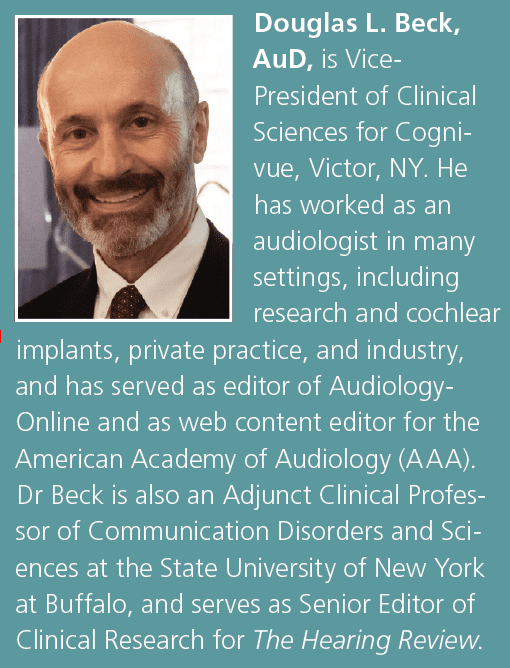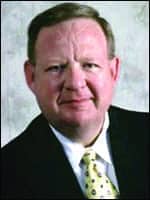Inside the Research| May 2022 Hearing Review
By Douglas Beck, AuD
As insurance coverage for hearing care services continues to grow and assume greater importance, so do the the myriad Current Procedural Terminology (CPT) codes that practices must use for reimbursement. But who actually creates these codes, and how are they established? Robert Fifer, PhD, an audiologist in the Department of Pediatrics at the University of Miami Miller School of Medicine, is one of the leading experts in CPT codes in hearing care and has been working with professional organizations in this area for nearly 30 years. As managed care, Medicare, and Medicaid become more prominent fixtures in the workaday lives of audiologists, we thought it would be a good idea to catch up with Dr Fifer and get some of his thoughts on the issue.
Beck: Hi Bob! Great to catch up with you! I know you’ve been working in the CPT billing coding arena for decades…and as such, I’d like to pick your brain! How did you get involved with CPT codes?
Fifer: I got involved back in 1994-95, when Bob Keith was president of the the American Academy of Audiology (AAA). Actually, that year, the American Medical Association (AMA) was having a meeting here in Miami, and Dr Keith asked if I would join the American Speech-Language-Hearing Association (ASHA) group to present and advocate for several new CPT codes for audiologists. Of course, I said yes, and I did exactly that, keeping him informed as things progressed.
When Dr Keith’s AAA presidency ended, so too did my work on behalf of AAA. However, shortly thereafter, ASHA asked if I would join their CPT coding task force.
Beck: I should explain the AMA actually owns the CPT codes, and they don’t give them out easily or quickly; obtaining new CPT codes is a long and arduous process, and there is no guarantee of an assigned CPT code at the end of the process. How long were you on the task force for ASHA?
Fifer: I think I was on the ASHA Task Force for two years initially, then rotated off for a year. It then became a standing committee at ASHA in 2001, when I was recruited again. I was asked to attend an AMA meeting for CPT code valuation that same year.
I served as the ASHA representative from 2002 to 2014. My work was primarily on the valuation side of CPT codes, but by virtue of committee structure, I was also on the CPT editorial side as the author or co-author of several new additional audiology codes.
In the beginning, I was like a lamb lost in the woods. So as you can imagine, I really worked hard to learn how to put a CPT proposal together. It is quite a process, as you mentioned. Luckily, I had a great mentor! Bernie Patashnic, a former Medicare director, offered his wonderful guidance and knowledge, as he was a consultant for the ASHA Healthcare Economic Committee. I left the committee at the end of 2015 and subsequently served on the ASHA Board of Directors.
Beck: So, during your time on the healthcare economic committee, you were constantly updating, defining, valuing, and redoing codes with the AMA and the allied health professionals to meet the changing needs of the professionals using the CPT codes?
Fifer: Absolutely. Sometimes previously approved codes get re-valuated. For example, Medicare might decide a code is being overused if the “typical patient” changes in some way, or if it has been more than 5 years since the last valuation because of possible changes in technology. In one case, we had a cochlear implant code that was considered more therapeutic than diagnostic. That code had to be rewritten and replaced by four new cochlear implant codes.
In 1966, when Medicare was first established, audiology was defined as a diagnostic profession only. To this day, Medicare considers audiology strictly diagnostic, and so the audiologists can bill Medicare for diagnostic tests, but, in general, not for therapeutic protocols or processes.
Beck: It seems the dichotomy of therapeutic versus diagnostic access to codes explains why speech language pathologists (SLPs) can use the Aural Rehabilitation (AR) CPT codes, but audiologists cannot?
Fifer: That is correct when addressing Medicare. AR is considered therapeutic, which is within the CPT code purview of SLPs. In response, we had to develop audiology-specific auditory therapeutic codes which are not billable to Medicare but can be billable to Medicaid in many states and to some private insurers.
Beck: If the bill were passed, would the Medicare Audiologist Access and Services Act (MAASA) change all of this to allow audiologists to bill for AR services?
Fifer: MAASA goes beyond that. MAASA would recognize audiologists for their entire scope of practice, including vestibular, vestibular rehab, aural rehab to support cochlear implant patients, as well as hearing aid utilization and follow-up.
It’s important to note that MAASA is not an expansion of scope: it simply recognizes the actual and historic scope of practice audiologists have engaged in daily for decades. All of this got lost more-or-less in the 1960s and 70s as audiologists became “tumor trackers” and later got more involved in hearing aids.
Beck: However, given the vast changes in professional practice in 2022, CPT codes have gained importance again, and it seems they need to be revisited. This brings up the obvious question: What does it take to make these changes?
Fifer: As you know, Doug, it literally takes an Act of Congress to pass the MAASA bill and to facilitate these changes. You see, the Social Security law identifies audiologists as a diagnostic profession, in the same category as diagnostic radiology, clinical laboratory, and a portion of diagnostic psychology. The common thread here are professions made up of diagnosticians. The way it is structured is that the physician orders the diagnostic tests from us, and then our role is to inform the physicians as to our findings and clinical conclusions, and then the physician makes the diagnosis.
Beck: Bob, given your experience and insight, what do you recommend regarding what the individual audiologists should do on behalf of the profession?
Fifer: There are a few things each of us should do to support audiology. For example, being involved with your state association makes a huge difference. The state association leaders can communicate with your state representatives, Congressional representatives, senators and staff and those representing the professionals within the state, and we can each do the same as private citizens, too. Visits, phone calls, letters to the representatives matter a lot.
The federal effort affects primarily Medicare reimbursement and, at times, commercial payer recognition of a particular procedure. But what happens at the state level determines our day-to-day scope of practice, reimbursement by Medicaid, and, more directly, reimbursement by commercial payers. MAASA is intended to promote our entire scope of practice at a federal level which, hopefully, will have a trickle-down effect for recognition at the state level.
Beck: And, as you mentioned, these new areas of recognition are not an expansion of scope of practice; rather they’re simply recognizing the work which has been done historically by audiologists for decades.
Fifer: Exactly. If audiologists cannot bill third-party payers for these necessary and ongoing clinical services which are already in their scope of practice, and for which they are licensed by their states, Medicare beneficiaries will have to pay out of pocket.
To a large degree, patients believe professional audiology services—which were “free” with hearing aids in the bundled billing world—will still be free. However, with the OTC model about to enter the scene, clinical services are not included. OTC hearing aids may change the entire business model for audiologists and other hearing care professionals (HCPs) in private practice and outpatient clinics.
This means that, unless the business models change, some questions will be difficult to answer, such as:
- Who is going to program and re-program these hearing aids?
- Who is going to work with the patient to teach them how to change/recharge batteries and place the hearing aids on their ears?
- Who is going to change the receivers, clean wax out of the receiver, or dirt/debris from the microphone—and what happens to the patient who after 3-4 months finds it’s totally occluded?
- Who will process the warranty repairs or place the claim for damaged or lost units?
The pharmacy tech probably isn’t going to have any idea what to do in any of these cases, and the patient will be very frustrated when they find out hearing aids need regular maintenance. Depending on how these questions are answered, I am optimistic that there is an opportunity for the professional services of audiologists to finally be fully recognized.
In the final analysis, it’s our job to advocate for the patients we serve, and probably the most effective way is through our professional state or national associations. If the state and federal systems don’t manage these things on the front end, it’ll get ugly on the back end!
Beck: Bob, let me switch topics and get your thoughts as to audiologists doing screenings, such as vision, cognition, or other types of screenings, as this is a topic with growing interest. I did vision screenings all the way back to the mid-1980s, before cochlear implants (CI) were FDA-approved for adults. I used to perform vision screening on CI candidates because we knew that for most people, having normal vision or normally corrected vision was a huge factor in their potential CI success. Further, I believe every audiologist has taken neuroanatomy and neurophysiology in their graduate/doctoral education, and most of us—probably 90% or more—studied speech-and-language and psychology, as well as other communication disorders, while earning our undergraduate degrees.
Fifer: Yes. This is an important topic as we move more towards professional services and practices, and as audiologists and SLPs become more accepted and integrated into the wider medical community. Over the last 10 years, Medicare has changed to a broader perspective along the lines of “How did you positively impact the patient’s quality of life (QoL) through your professional services?”
The back story on this change focuses on the fact that too many Medicare patients were not getting well and were not attaining a good QoL following the delivery of their approved Medicare services. Medicare’s evaluation of the situation found several factors contributing to these outcomes that are preventable. As a result, Medicare wants all healthcare providers—both physicians and non-physicians—to execute a series of screening measures.
For example, Medicare requires a depression screening or a cognitive screening for tinnitus patients to provide an outcomes measure that assures they are doing well or are being treated successfully. Likewise, older individuals with hearing loss are at increased risk for falls. Consequently, Medicare wants all healthcare providers to screen patients for falls risk.
Of course, much has been written about this, but for those who aren’t aware, hearing loss is the single most important modifiable risk factor regarding dementia risk.1 Therefore, it’s a real and pragmatic concern of Medicare to have licensed healthcare practitioners screen for health conditions which can be more readily managed when caught early, and thus provide a better QoL for patients.
In the long run, early intervention costs the patient and the healthcare system much less money and energy.2 In fact, Medicare requests and/or requires these screenings to be done depending on the number of Medicare patients seen in the practice or the billing profile for Medicare patients in the practice.
Beck: Can you tell me more about this?
Fifer: About 15 years ago, CMS established the Physician Quality Reporting Initiative or PQRI.3 Eligible professionals who successfully report a statutory minimum number of quality measures on claims earn an incentive equivalent to 1.5% of total allowed charges for covered Medicare Physician Fee Schedule (MPFS) services. The allowed charges on which the 1.5% incentive will be calculated are not limited to those services to which PQRI quality measures are applicable, but the allowed charges for all MPFS services furnished during the reporting period.
Beck: However, the Catch-22 here is that, by law, Medicare cannot pay for screenings—yet they require screenings as part of our diagnostic procedures. Is that correct?
Fifer: Yes, and so it’s bundled into what we do diagnostically.
Beck: Let me see if I understand this correctly: Let’s say I have a 75-year-old patient with suspected hearing loss, and his primary care physician (PCP) has referred him to me to rule out hearing loss. Subsequently, I find and report to the PCP that the patient has mild-moderate sensorineural hearing loss (SNHL). Am I then supposed to also do a depression or cognitive screening?
Fifer: Yes. For Medicare (Part B) patients, it’s administered under a program called MIPS or the Merit-based Incentive Payment System.4 If you find tinnitus or SNHL, you’re supposed to see how that primary problem impacts their QoL via these screenings.
Of note, to qualify as an audiology MIPS participant, there is a minimum number of patients seen per year and a threshold of Medicare dollars billed when MIPS kicks in. Off the top of my head, the thresholds are along the lines of about 200 distinct Medicare patients per year, or 200 or more distinct procedures, or some $90,000 in Medicare billing. Once you cross those thresholds, you’re required to participate in MIPS, and if you don’t, your reimbursement is decreased by several percentage points, perhaps some 7-9%.
Further, MIPS is broadly applied to many QOL issues, such as smoking cessation, obesity, alcoholism, elder abuse, and more. Medicare is moving more into interdisciplinary interactions and QoL issues, with the goal of creating a more complete and comprehensive picture of the patient, thereby allowing the PCP to better direct and address the QoL for the patients we serve.
Audiology-specific information can be found on the respective audiology organizational websites and the Audiology Quality Consortium webpage (https://audiologyquality.org). There is also available a link for each provider to determine, by the NPI identifier, whether they qualify for MIPS mandatory enrollment. Medicare MIPS has captured the greatest attention, but the concept applies to all ages although most commercial payers have not yet adopted these standards.
Beck: This is quite enlightening! I wasn’t aware of these details and I certainly appreciate you sharing your time and knowledge on these matters, Bob.
Fifer: My pleasure, Doug. Thanks for asking!

Correspondence can be addressed to Dr Beck at: [email protected].
Citation for this article: Beck DL. CPT Codes, MAASA, scope of practice, Medicare, and more: An interview with Robert Fifer, PhD. Hearing Review. 2022;29(5):28-31.
References
- Livingston G, Huntley J, Sommerlad A, et al. Dementia prevention, intervention, and care: 2020 report of the Lancet Commission. Lancet. 2020;396(10248):413-446.
- Kauffman L. Hearing and Value-based Healthcare. Hearing Review featured report. https://hearingreview.com/wp-content/uploads/2018/03/ValueBasedHearingCare_FeatureReport_0318HR.pdf. Published March 3, 2018.
- Centers for Medicare and Medicaid Services (CMS). Physician Quality Reporting System (PQRS) Overview. https://www.cms.gov/medicare/quality-initiatives-patient-assessment-instruments/pqrs/downloads/pqrs_overviewfactsheet_2013_08_06.pdf.
- Centers for Medicare and Medicaid Services (CMS) website. Merit-based Incentive Payment System (MIPS)–Participation Options Overview. https://qpp.cms.gov/mips/overview.





